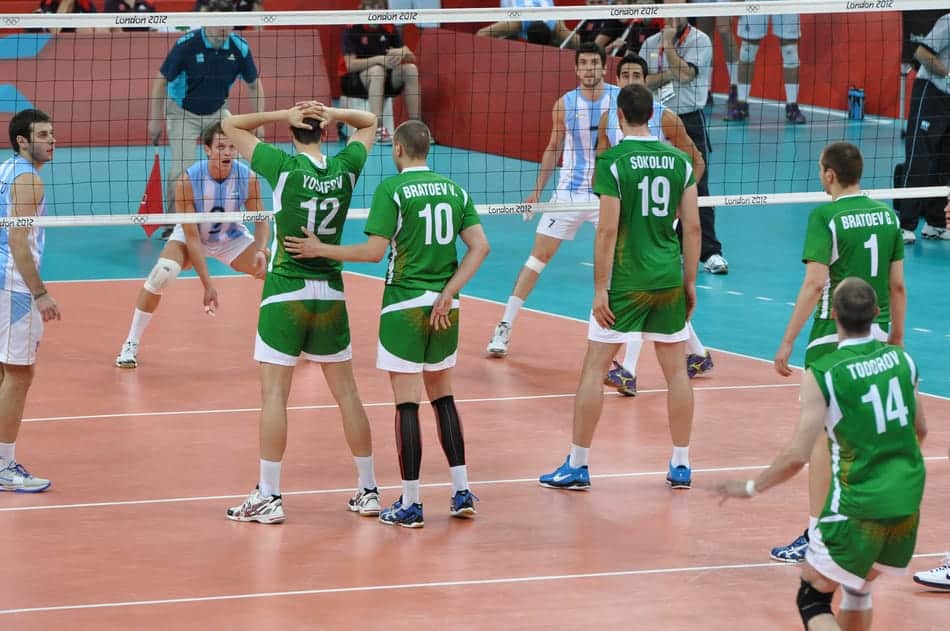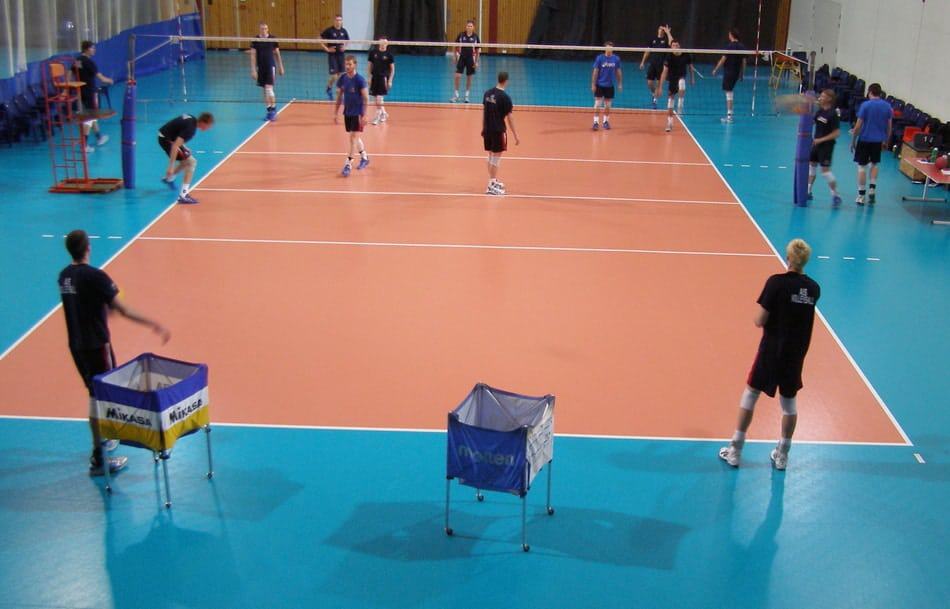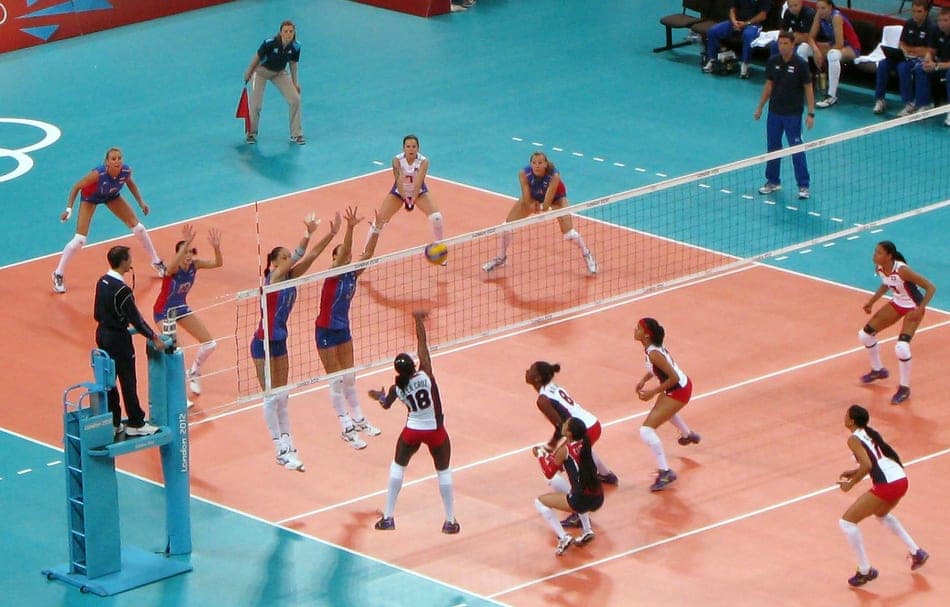Playing volleyball is great for fitness and fun. Whether you are playing as part of a professional team or just for fun, it really helps to understand the rules, the layout of the court (the various zones), and the responsibilities of the various positions and players, if you want to work as a team and win.
As a team sport and one that is meant to be played competitively, coaches and team captains focus on helping teams to understand the court and the various rules that apply while also developing strong strategy and skills.
What is an attack line in volleyball? The attack line, also called the “10ft line”, is a line that is 10 feet (or 3 meters) away from the net. Players in the back row can only attack the ball above the net if they take off from behind the attack line.

Understanding the significance and function of the volleyball attack line can really help a team to pull together and play the best game possible. Read on to learn why there is an attack line, what the front zone is and whether or not libero players can play from inside the attack line.
Why Is There An Attack Line In Volleyball?
It may seem like the attack line separates the team players into the front row and back row players. Positions 1, 5, and 6 play in the back row, behind the attack line. Players 2, 3, and 4, play in the front row near, on, or in front of the attack line.
If this sounds confusing, you can learn all about rotation positions in The 8 Parts To Understanding Rotation In Volleyball.
The attack line does not actually separate front and back row players, although it may look like it when they are in their base rotation positions. You’ll notice with more advanced teams at higher levels, the players line up in different formations and the attack line really has no limitation on where they stand. Once the ball is served, players may move anywhere on the court, but the players that are in the base rotational position on the back row (positions 1, 5 and 6 must still follow the rules limiting their attacks).
Front row players are involved in freely blocking and attacking the ball at the net, but the back row players are only allowed to hit the ball over the net if they are behind or jump from behind the 10ft line.
What Is The Front Zone?
Where is the front zone and what is its purpose? The front zone in volleyball is the area between the attack line and the centerline. Front row players which are players in positions 2, 3, and 4, usually start the play in this zone or close to it. The players in the front zone can be considered attack zone players and are tasked with setting, attacking, and blocking the ball.

Front zone play, in a nutshell…
When players in the front zone attack a ball, his or her hand may cross the net without fearing a fault. This is only allowed if contact with the ball was initially made within the front zone space and no contact was made with an opponent or the net.
When front zone players block the ball, they can also reach across the net. This is only allowed if there is no following interference with the opposing team’s play. It is illegal to block the opposing team’s serve.
There is a bit of added pressure on front zone players in terms of faults. Players simply need to be mindful when potential faults may occur. A player cannot contact or interfere with the opposing team’s play on the ball – this is considered a fault.
A hand or foot may touch the centerline (they may touch the opposing team’s court), but this is only considered legal if the there is no contact with the opposing team and the crossing is not intended to interfere with play. If a player unintentionally touches the net and it does not interfere with play, there will be no fault assigned.
To learn more about rules around the net, check our post called 23 Net Violations In Volleyball And The Rules Behind Them.
Different Zones And Lines On The Volleyball Court
If you are a volleyball newbie or simply haven’t played in a number of years, you may have difficulty telling the lines apart or even knowing them in the first place. All of the lines on the volleyball court serve a specific purpose and has an impact on how the game is refereed and how you and your teammates will play the game. It is important for each team member to understand the function of each line on the court.

The volleyball court consists of the following zones, lines, and markings in addition to the attack line:
- Centerline – beneath the net is the centreline. This line divides the court into two sides, one for each team.
- Baseline – this is the line at the very end of the volleyball court.
- Sidelines – these are the lines on the sides of the court often called “boundary lines”. They connect to the baselines and measure 60 feet in length.
- Backcourt – the area behind the attack line, in front of the baseline or end line.
- Free zone – this is outside of the boundary lines where players are still allowed to make occasional plays.
- Substitution zone – this is where substitutes enter the game. The zone runs along the sideline and is between the centreline and the attack line.
- Replacement zone – this is where Libero players enter to replace players in the back row.
It is important that each player can identify each of these lines and understands their purpose. This isn’t only for match purposes, but also to ensure that players aren’t confused during training and practices when coaches are giving instruction.
If you want to learn more about the lines to be able to serve as a line judge, take a moment and read this post called Volleyball: Is It In Or Out?
Can A Libero Play Inside The Attack Line?
The libero position can be confusing for many people. Of course, when just starting out as a libero player, you might wonder if you are allowed to play from inside the attack line or if it is possible for a libero player to cross the attack line.
The simple answer is yes, the libero can play in front of the attack line, but with some extra restrictions, so you have to be careful.
Where the libero is on the court AND what sort of setting action that they use, can be a touchy situation. For instance, if a libero is playing from inside or on the attack line (in the front zone instead of the back zone), and uses overhand finger action to set the ball (a typical volley), the other players are not allowed to complete an attack hit on the ball, if it is higher than the net’s top.

If players do complete an attack hit in this particular type of scenario, it is considered an illegal attack, which means the play will be blown dead and you will lose the point. To ensure that illegal attacks do not happen, teammates need to pay close attention to the action a libero player uses when setting the ball from around the front zone.
One way around this is for the libero to only bump set (using their platform pass to set) whenever they are touching or inside the front zone. The other option if they are close to the front zone is to lift whichever foot is touching or crossing over the attack line as they make their setting contact.
To learn all about the libero position, check out our article called Master Guide To Liberos In Volleyball: Rules, Rotation, And Tips.
Last Word About The Attack Line
The attack line in volleyball is a line 10 feet from the net that has a different meaning for players in the front row or the back row. It divides the court up and ensures that not all players can be open to attack the net at the same time. Can you imagine trying to block as 5 players approach for an attack on the ball? No one would want to play in a game like that.
It is a good idea to ensure that your whole team knows the purpose of the attack line and what its function is.
Photo credits:
Feature image by Grzegorz Jereczek on flickr.com: https://creativecommons.org/licenses/by-sa/2.0/
Yellow team image by Francisco Antunes on flickr.com: https://creativecommons.org/licenses/by/2.0/
Front zone image by Marco Verch on flickr.com: https://creativecommons.org/licenses/by/2.0/
Practice court image by Stonestreet’s Coaches – The Extra Mile on flickr.com: https://creativecommons.org/licenses/by-nd/2.0/, cropped.
Libero image by Bill Tyne on flickr.com: https://creativecommons.org/licenses/by-sa/2.0/
Recent Posts
Athletes, listen up! Do you have a closet full of old jerseys, sweatpants, and tees that you just can't seem to part with? Well, dust them off, because you're sitting on a goldmine of fashion...
You may have heard, or you may have noticed, that there's been a change to the rule about double contact in volleyball. In 2022, an experimental rule change began to be implemented, where the double...
